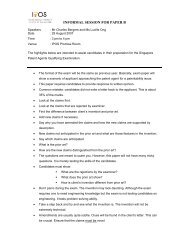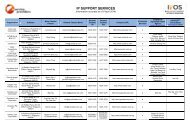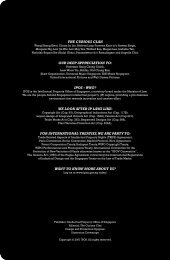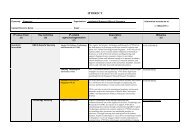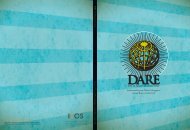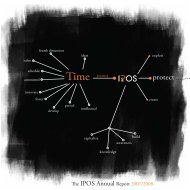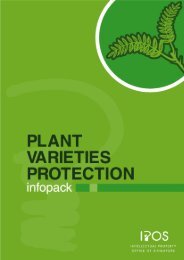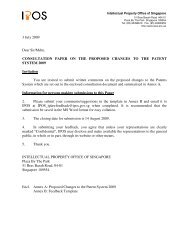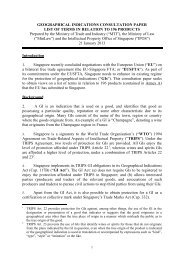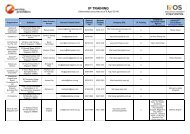Shape Marks - Intellectual Property Office of Singapore
Shape Marks - Intellectual Property Office of Singapore
Shape Marks - Intellectual Property Office of Singapore
- No tags were found...
Create successful ePaper yourself
Turn your PDF publications into a flip-book with our unique Google optimized e-Paper software.
SHAPE MARKSCopyright © 2012 <strong>Intellectual</strong> <strong>Property</strong> <strong>Office</strong> <strong>of</strong> <strong>Singapore</strong>.You may download, view, print and reproduce this document without modifications, butonly for non-commercial use. All other rights are reserved. This document and itscontents are made available on an "as is" basis, and all implied warranties are disclaimed.The contents <strong>of</strong> this document do not constitute, and should not be relied on as, legaladvice. You should approach a legal pr<strong>of</strong>essional if you require legal advice.Version 1 (13 January 2006)<strong>Intellectual</strong> <strong>Property</strong> <strong>Office</strong> <strong>of</strong> <strong>Singapore</strong>
<strong>Shape</strong> marksSHAPE MARKSContents:Page1 Introduction 22 Relevant legislation 33 Representation <strong>of</strong> shape marks 4(a) Description <strong>of</strong> the mark 4(b) Indication on Form TM 4 44 Section 7(3) objections applicable to 2-dimensional and 3-dimensional shape marks 55 Specification 66 Registrability <strong>of</strong> shape marks 7(a) Section 7(3)(a) – <strong>Shape</strong>s resulting from the nature <strong>of</strong> the goods 7(b) Section 7(3)(b) – <strong>Shape</strong>s that are necessary to obtain a technical result 8(c) Section 7(3)(c) – <strong>Shape</strong>s which give substantial value to the goods 87 Assessing distinctiveness <strong>of</strong> shape marks 9(a) Whether the shape is devoid <strong>of</strong> distinctive character 9(b) Uniqueness is not the same as distinctiveness as a trade mark 13(c) Mere product recognition is not sufficient 14(d) Interplay between the various objections 158 Acquired distinctiveness 17(a) Whether the 3-D mark has acquired distinctiveness by virtue <strong>of</strong> use 17(b) Evaluation <strong>of</strong> evidence 17(c) De facto monopoly 189 Indistinctive shape with distinctive elements 2010 <strong>Shape</strong> <strong>of</strong> packaging or aspect <strong>of</strong> packaging 21(a) Where it is not clear whether the trade mark is the shape <strong>of</strong> packaging or 21the shape <strong>of</strong> the goods(b) Where the goods have no shape (e.g. liquids) 22Version 1 (13 January 2006) Page 1 <strong>Intellectual</strong> <strong>Property</strong> <strong>Office</strong> <strong>of</strong> <strong>Singapore</strong>
<strong>Shape</strong> marks1 INTRODUCTIONThe shape marks covered by this chapter includes two-dimensional and threedimensionalshape marks. <strong>Shape</strong> marks may also be a faithful representation or not afaithful representation <strong>of</strong> the goods themselves.Version 1 (13 January 2006) Page 2 <strong>Intellectual</strong> <strong>Property</strong> <strong>Office</strong> <strong>of</strong> <strong>Singapore</strong>
<strong>Shape</strong> marks2 RELEVANT LEGISLATIONTrade <strong>Marks</strong> Act [Cap. 332, 2005 Ed.]Absolute grounds for refusal <strong>of</strong> registration7. —(1) The following shall not be registered:(a) signs which do not satisfy the definition <strong>of</strong> a trade mark in section 2(1);(b) trade marks which are devoid <strong>of</strong> any distinctive character;(c) trade marks which consist exclusively <strong>of</strong> signs or indications which may serve, intrade, to designate the kind, quality, quantity, intended purpose, value, geographicalorigin, the time <strong>of</strong> production <strong>of</strong> goods or <strong>of</strong> rendering <strong>of</strong> services, or other characteristics<strong>of</strong> goods or services; and(d) trade marks which consist exclusively <strong>of</strong> signs or indications which have becomecustomary in the current language or in the bona fide and established practices <strong>of</strong> thetrade.(2) A trade mark shall not be refused registration by virtue <strong>of</strong> subsection (1)(b), (c) or (d)if, before the date <strong>of</strong> application for registration, it has in fact acquired a distinctivecharacter as a result <strong>of</strong> the use made <strong>of</strong> it.(3) A sign shall not be registered as a trade mark if it consists exclusively <strong>of</strong> —(a) the shape which results from the nature <strong>of</strong> the goods themselves;(b) the shape <strong>of</strong> goods which is necessary to obtain a technical result; or(c) the shape which gives substantial value to the goods.Trade <strong>Marks</strong> RulesApplication for registration15. —(2) An application for the registration <strong>of</strong> a 3-dimensional shape as a trade markshall not be treated as such unless the application form contains a statement to that effect.Version 1 (13 January 2006) Page 3 <strong>Intellectual</strong> <strong>Property</strong> <strong>Office</strong> <strong>of</strong> <strong>Singapore</strong>
<strong>Shape</strong> marks3 REPRESENTATION OF SHAPE MARKSThe representation <strong>of</strong> a shape trade mark should where practicable, be in the form <strong>of</strong> aperspective or isometric drawing that shows clearly all the features <strong>of</strong> the trade mark. Theparts <strong>of</strong> the configuration claimed to constitute the trade mark should be shown in solidlines, while the unclaimed parts, if any, should be shown in broken lines.(See Chapter on “What is a trade mark?” on how shape marks should be graphicallyrepresented.)(a) Description <strong>of</strong> the markThe Examiner should ensure that there is no discrepancy between the description andthe graphical representation and the relationship between them is clearly spelled out,for example by including a cross reference to the representation in the description. Itis important to note that such a description is an integral part <strong>of</strong> the representation <strong>of</strong>the trade mark.If a description is supplied after filing, then care should be taken to ensure that thedescription is exactly in accord with the trade mark as filed as any difference betweenthe representation and description may affect the identity <strong>of</strong> the trade mark and,therefore, would constitute an unallowable amendment to the trade mark.The examiner will usually require that the description includes words such as “... asshown in the representation on the application” to qualify that the description islimited by reference to the drawing or representation.(b) Indication on Form TM 4If the applicant is seeking protection for a 3D shape, he should tick the appropriatebox on Form TM 4. Rule 15(2) <strong>of</strong> the Trade <strong>Marks</strong> Rules states that an applicationfor the registration <strong>of</strong> a 3D mark will not be treated as such unless the applicationform contains a statement to that effect. This indication, together with therepresentation and description, will indicate clearly that the applicant is applying for a3D shape mark.Version 1 (13 January 2006) Page 4 <strong>Intellectual</strong> <strong>Property</strong> <strong>Office</strong> <strong>of</strong> <strong>Singapore</strong>
<strong>Shape</strong> marks4 SECTION 7(3) OBJECTIONS APPLICABLE TO 2-DIMENSIONAL AND 3-DIMENSIONAL SHAPE MARKS<strong>Shape</strong> suggests three-dimensional form. Confusion however arises where, although thesign sought to be registered appears to be a 3D shape mark, the graphic representation isin two-dimensions. The Registrar will ask the question, “Is such a sign a threedimensionalshape or a two-dimensional drawing or picture <strong>of</strong> a figurative mark?”Usually the answer to this question should be clear from the indication/description <strong>of</strong>the mark on the application form. But even if it is not, it should make no difference to theapplicability <strong>of</strong> Section 7(3). This was the approach taken in Philips v Remington [1998]R.P.C. 283. The sign there was a picture <strong>of</strong> the head <strong>of</strong> a three-headed shaver.Thus, Section 7(3) objections can be raised for 2-D graphical representation <strong>of</strong> a 3-Dshape mark. In the Philips case, it was found that the mark was objectionable under anequivalent <strong>of</strong> our Section 7(3)(b) – that the sign was <strong>of</strong> a shape which was necessary toobtain a technical result, thus, it shall be refused registration.Version 1 (13 January 2006) Page 5 <strong>Intellectual</strong> <strong>Property</strong> <strong>Office</strong> <strong>of</strong> <strong>Singapore</strong>
<strong>Shape</strong> marks5 SPECIFICATIONWhere the shape is <strong>of</strong> the goods themselves, or a container for the goods, thespecification should be confined to the goods represented, or to the goods sold in thecontainer represented, otherwise there is the question <strong>of</strong> whether the applicant intends touse the mark for the specified goods.For example, where the mark concerned is the shape <strong>of</strong> a bottle, then a specificationunder class 3 for “perfumes” will be acceptable while “eyebrow pencils” will not beacceptable.Version 1 (13 January 2006) Page 6 <strong>Intellectual</strong> <strong>Property</strong> <strong>Office</strong> <strong>of</strong> <strong>Singapore</strong>
<strong>Shape</strong> marks6 REGISTRABILITY OF SHAPE MARKSIn examination <strong>of</strong> the registrability <strong>of</strong> shape marks, the first hurdle will be whether theshape falls foul <strong>of</strong> Section 7(3) <strong>of</strong> the Trade <strong>Marks</strong> Act.It must be noted that if any <strong>of</strong> the criteria listed in Section 7(3) is satisfied, the signcannot be registered as a trade mark. Furthermore, even substantial evidence <strong>of</strong> use willnot overcome the fundamental objection that the shape cannot be registered as a trademark.(a) Section 7(3)(a) - <strong>Shape</strong>s resulting from the nature <strong>of</strong> the goodsThis ground prevents the registration <strong>of</strong> shapes that result from the nature <strong>of</strong> thegoods. It is not concerned to prevent registration <strong>of</strong> marks consisting <strong>of</strong> the shapes <strong>of</strong>the goods themselves as shapes <strong>of</strong> distinctively shaped goods can function as a trademark, but rather, shapes that result from the nature <strong>of</strong> the goods.The nature <strong>of</strong> the goods refers to their essential qualities or innate characteristics. Forexample, a sign consisting <strong>of</strong> the shape <strong>of</strong> a banana for bananas would be a shape,which results from the nature <strong>of</strong> the goods themselves. So too, would a signconsisting <strong>of</strong> a bunch <strong>of</strong> bananas for bananas. To assess whether a shape is onewhich results from the nature <strong>of</strong> the goods, the Registrar will look at the goods todetermine their nature and consider the following:(i) the extent to which the shape is regarded as the “normal” shape <strong>of</strong> the goods;(ii) where the goods have a “uniform” shape, whether the shape is a variation fromthe “uniform” shape; if so, the shape may not be objectionable on the groundthat it results from the nature <strong>of</strong> the goods;(iii) where the goods come naturally in a range <strong>of</strong> shapes, then any one <strong>of</strong> the usualshapes will be open to objections.ExampleA picture <strong>of</strong> a lemon as a proposed trade mark for lemons would not be acceptablebecause the sign would consist exclusively <strong>of</strong> a shape which results from the nature <strong>of</strong>the goods themselves – lemons. Likewise a picture <strong>of</strong> lemons on the branch, or asilhouette <strong>of</strong> a lemon.If the goods were lemon juice, then a picture <strong>of</strong> a lemon should not fall foul <strong>of</strong> thisprovision. Likewise if the proposed mark was a yellow plastic container in the shape<strong>of</strong> a lemon, the shape may not be objected to on the ground that it results from thenature <strong>of</strong> the goods.Where the specification is wide, “the goods” refer to any <strong>of</strong> the goods in respect <strong>of</strong>which the mark is sought to be registered. Thus, a picture <strong>of</strong> a banana for fruit wouldbe just as objectionable as a picture <strong>of</strong> a banana for bananas.Version 1 (13 January 2006) Page 7 <strong>Intellectual</strong> <strong>Property</strong> <strong>Office</strong> <strong>of</strong> <strong>Singapore</strong>
<strong>Shape</strong> marksAlthough the natural shapes <strong>of</strong> the goods in question cannot be registered, if the shapehas been the subject <strong>of</strong> substantial design input, then this objection no longer applies.For example, in Philips v Remington (Case C-299/99), Phillips’ 3-headed shavermark for “electric shavers” did not fall foul <strong>of</strong> this particular provision since the markis considered to have been subject to a substantial design input.There is some overlap between this objection and the objections on the grounds thatthe mark is devoid <strong>of</strong> distinctive character or that the mark is descriptive <strong>of</strong> the goodsor services. For example, where the trade mark is a picture <strong>of</strong> a bunch <strong>of</strong> bananas forbananas, obviously, objections can also be taken that the mark is descriptive and thus,not distinctive <strong>of</strong> the goods in question.(b) Section 7(3)(b) - <strong>Shape</strong>s that are necessary to obtain a technical resultThe purpose <strong>of</strong> this provision is to exclude shapes which are merely functional in thesense that they are motivated by and are the result <strong>of</strong> technical considerations.The ECJ in the Philips v Remington case ruled that a sign consisting exclusively <strong>of</strong>the shape <strong>of</strong> the goods is unregistrable under this provision if the essential features <strong>of</strong>that shape are attributable only to the technical result. The fact that there are othershapes which allow the same technical result to be obtained is no defence.A shape which is necessary to obtain a technical result is also likely to indicate theintended purpose <strong>of</strong> the goods, or it may be customary in the trade and therefore, nondistinctive.Thus, the grounds under Section 7(1)(b) (that the shape is devoid <strong>of</strong>distinctive character), Section 7(1)(c) (that the shape exclusively designates theintended purpose or a characteristic <strong>of</strong> the goods) and Section 7(1)(d) (that the shapeis a shape that is customary in the bona fide and established practices <strong>of</strong> the relevanttrade) would also apply.(c) Section 7(3)(c) - <strong>Shape</strong>s which give substantial value to the goodsThe purpose <strong>of</strong> this provision is to exclude “aesthetic-type shapes” (see remarks <strong>of</strong>the UK Court <strong>of</strong> Appeal in Philips v Remington), i.e., shapes which have eye appealor are purchased primarily because <strong>of</strong> the eye appeal, for example, novelty soaps,ornaments, figurines, toys, etc. The decision whether the value is substantial requires,“a comparison … between the shape sought to be registered and shapes <strong>of</strong> equivalentarticles. It is only if the shape has, in relative terms, substantial value that it will beexcluded from registration.” Any other value, for example, value due to use <strong>of</strong> betterquality materials, should be disregarded.Version 1 (13 January 2006) Page 8 <strong>Intellectual</strong> <strong>Property</strong> <strong>Office</strong> <strong>of</strong> <strong>Singapore</strong>
<strong>Shape</strong> marks7 ASSESSING DISTINCTIVENESS OF SHAPE MARKS(a) Whether the shape is devoid <strong>of</strong> distinctive characterEven if the preliminary obstacle under Section 7(3) is overcome, it is still necessaryto ascertain whether a 3-D mark is to be refused registration under one or more <strong>of</strong> theabsolute grounds for refusal – including whether the mark is devoid <strong>of</strong> distinctivecharacter. The ECJ in Philips v Remington has settled for us the question whether“there is a special category <strong>of</strong> marks which, even though not devoid <strong>of</strong> distinctivecharacter in fact are none the less incapable <strong>of</strong> being a trade mark as a matter <strong>of</strong>law” and the answer is “no”. This means that there is no need to consider thequestion whether the 3-D mark can, by itself, function as a trade mark within thedefinition <strong>of</strong> a trade mark because, the answer is yes, a 3-D mark can function as atrade mark. What needs to be considered is whether the mark is devoid <strong>of</strong> distinctivecharacter or is objectionable due to any <strong>of</strong> the other absolute grounds <strong>of</strong> refusal (e.g.the mark is descriptive <strong>of</strong> the goods).With respect to the absolute grounds <strong>of</strong> refusal, there is no distinction between thedifferent categories <strong>of</strong> trade marks. The criteria for assessing the distinctive character<strong>of</strong> 3-D marks are thus no different from those to be applied to other categories <strong>of</strong>marks. As such, in order to be capable <strong>of</strong> distinguishing the goods, the shape <strong>of</strong> anarticle in respect <strong>of</strong> which a sign is registered does not require any capricious additione.g., an embellishment which has no functional purpose (see Philips v Remington).The test is simply, whether the mark serves to identify the product in respect <strong>of</strong> whichregistration is applied for as originating from a particular person, and thus, is capable<strong>of</strong> distinguishing the goods and services <strong>of</strong> one person from goods and services <strong>of</strong>other persons. A trade mark’s distinctiveness must be assessed by reference to first,the goods or services in respect <strong>of</strong> which registration is sought and second, byreference to the perception <strong>of</strong> the relevant persons, namely the consumers <strong>of</strong> thegoods or services (Rewe Zentral v OHIM [2002] ECR II-705, paragraph 27; Boschv OHIM [2002] ECR II-4881, paragraph 20). It is relevant to look at the presumedexpectations <strong>of</strong> the average consumer <strong>of</strong> the category <strong>of</strong> goods or services in question,and assuming that such a consumer is reasonably well informed and reasonablyobservant and circumspect (see Philips v Remington). So, “… it may in practice bemore difficult to establish distinctiveness in relation to a shape <strong>of</strong> product mark thana word or figurative trade mark. But whilst that may explain why such a mark isrefused registration, it does not mean that it cannot acquire distinctive characterfollowing the use that has been made <strong>of</strong> it and thus registered as a trade mark…” (seeLinde AG (Case C-53/01) at paragraph 48).As the perception <strong>of</strong> the average consumer is a relevant question, “account must betaken <strong>of</strong> the fact that the perception <strong>of</strong> the relevant section <strong>of</strong> the public is notnecessarily the same in relation to a figurative mark consisting <strong>of</strong> a faithfulrepresentation <strong>of</strong> the product itself as it is in relation to a word mark or a figurativeor three dimensional mark not faithfully representing the product. Whilst the publicVersion 1 (13 January 2006) Page 9 <strong>Intellectual</strong> <strong>Property</strong> <strong>Office</strong> <strong>of</strong> <strong>Singapore</strong>
<strong>Shape</strong> marksis used to recognising the latter marks instantly as signs identifying the product, thisis not necessarily so where the sign is indistinguishable from the appearance <strong>of</strong> theproduct itself.” (see Henkel KGaA v OHIM (Case T-30/00) at paragraph 49).The European Court <strong>of</strong> First Instance has found the following 3-D shape marks to benon-registrable:(i) “a rectangular parallelepiped shape with rounded edges” for soaps (Reason: arectangular parallelepiped is a shape commonly used for soaps. Where theclaimed shape is a slight variation <strong>of</strong> the various parallelepipedal shapescommonly used for soaps, it will not enable the relevant public to distinguishimmediately and with certainty the applicant’s soaps from those having adifferent trade origin);(ii) “round tablet, comprising two layers, whose colours, white (lower part) and red(upper part) are also claimed for registration” in respect <strong>of</strong> washing ordishwashing preparations in tablet form (Reason: the 3-dimensional shape…, around tablet, is one <strong>of</strong> the basic geometrical shapes and is an obvious one for aproduct intended for use in washing machines or dishwashers… Where, as in thepresent case, the target sector <strong>of</strong> the public sees the presence <strong>of</strong> colouredelements as a suggestion that the product has certain qualities, and not as anindication <strong>of</strong> its origin, there is no distinctive character).The European Court <strong>of</strong> First Instance has, however found the following 3-D shapes tobe registrable:“a bottle comprising a main section with, at its base, a recess, in the shape <strong>of</strong> aslightly truncated cone with, in its flat section, a stylised star in relief. In the lowerpart <strong>of</strong> the main section, which is nearly cylindrical from bottom to top, there is aninitial series <strong>of</strong> wavy grooves and, in the upper part, which is <strong>of</strong> slightly smallerdiameter and bobbin-shaped, there are spiralling grooves which form lozenges whenseen through the bottle. The top section, which is the shape <strong>of</strong> a slightly truncatedcone, ends in a cylindrical neck with a blue cap” in respect <strong>of</strong> beverages (Reason:although the bottle’s bobbin shape and the oblique, horizontal grooves are admittedlyfeatures <strong>of</strong> numerous bottles currently available on the market, particular note shouldbe taken <strong>of</strong> the manner in which those various elements are put together. In thatregard, it should be emphasized that a sign consisting <strong>of</strong> a combination <strong>of</strong> elements,each <strong>of</strong> which is devoid <strong>of</strong> any distinctive character, can be distinctive provided thatconcrete evidence, such as, for example, the way in which the various elements arecombined, indicates that the sign is greater than the mere sum <strong>of</strong> its constituentparts…the combination <strong>of</strong> the parts in this case, is truly specific and cannot beregarded as commonplace. The nearly cylindrical main section <strong>of</strong> the bottle bearsoblique grooves which, first, completely cover the bobbin-like part <strong>of</strong> the bottle andaccentuate the curved, rounded effect <strong>of</strong> the bottle’s upper part and second, arehighlighted by the presence on the lower part <strong>of</strong> the bottle <strong>of</strong> grooves running in theopposite direction, the whole forming a design which is striking and easy toremember. That combination thus gives the bottle at issue a particular appearancewhich, taking account also <strong>of</strong> the overall aesthetic result, is capable <strong>of</strong> holding theattention <strong>of</strong> the public concerned and enabling the public, made aware <strong>of</strong> the shape <strong>of</strong>Version 1 (13 January 2006) Page 10 <strong>Intellectual</strong> <strong>Property</strong> <strong>Office</strong> <strong>of</strong> <strong>Singapore</strong>
<strong>Shape</strong> marksthe packaging <strong>of</strong> the goods in question, to distinguish the goods covered by theregistration application from those with a different commercial origin).Example 1<strong>Singapore</strong> Application No. : T01/14770JApplicant: Société Des Produits Nestlé S.A.Date <strong>of</strong> application : 15 July 2001Mark: 3D shape <strong>of</strong> packaging <strong>of</strong> the goods.Class 30: C<strong>of</strong>fee and c<strong>of</strong>fee mixtures.Objection: Devoid <strong>of</strong> distinctive character.Decision: The mark is not acceptable as it is quite unlikely that the mark will berecognised as a trade source. The packaging is one that the target sector <strong>of</strong> the publicwill see as signifying certain functionalities, for example, as a container for holdingthe c<strong>of</strong>fee mixture, and not as an indication <strong>of</strong> its origin. There is no distinctivecharacter in the packaging. The public is likely to recognise the applicant’s housemark, rather than the container as the trade mark. The Registrar took intoconsideration the fact that similar containers with a peel-<strong>of</strong>f cover have been in use inthe market for other products such as dairy creams, fruit jellies, instant noodles andice-creams.Example 2<strong>Singapore</strong> Application No. : T0412651HApplicant: Bismarck Premium Brands GMBHDate <strong>of</strong> application : 21 April 2004Mark: 3-D “lady-shaped” bottle.Version 1 (13 January 2006) Page 11 <strong>Intellectual</strong> <strong>Property</strong> <strong>Office</strong> <strong>of</strong> <strong>Singapore</strong>
<strong>Shape</strong> marksClass 32 and Class 33: Beverages and alcoholic beverages.Decision: The mark is acceptable as it consists <strong>of</strong> an unusual 3-D shape <strong>of</strong> a bottlewhich gives the bottle a particular appearance which, taking account also <strong>of</strong> theoverall aesthetic result, is capable <strong>of</strong> holding the attention <strong>of</strong> the public concerned andenabling the public, made aware <strong>of</strong> the shape <strong>of</strong> the packaging <strong>of</strong> the goods inquestion, to distinguish the goods covered by the registration application from thosewith a different commercial origin. From the perspective <strong>of</strong> the average consumer,the distinctive shape functions as the indicator <strong>of</strong> the source or origin <strong>of</strong> the productsand is therefore, capable <strong>of</strong> distinguishing the applicant.Example 3<strong>Singapore</strong> Application No.ApplicantDate <strong>of</strong> applicationMark: T99/12636G: Unilever PLC: 4 November1999: The mark consists <strong>of</strong> a three-dimensional shape <strong>of</strong>a speckled capsule.Version 1 (13 January 2006) Page 12 <strong>Intellectual</strong> <strong>Property</strong> <strong>Office</strong> <strong>of</strong> <strong>Singapore</strong>
<strong>Shape</strong> marksExampleYakult Honsha KK’s Trade Mark Application [2001] R.P.C. 39Mark: 3D shape <strong>of</strong> a bottle.Class 29: Jellies, jams; eggs, milk and other dairy products, including yoghurt andyoghurt preparations; edible oils and fats; preserves, pickles; and meat, fish, poultryand game preparations and extracts.Class 32: non alcoholic drinks; syrups and other preparations for making beverages.Objection: Devoid <strong>of</strong> distinctive character.Decision: The fact that a container is unusual or attractive per se does not mean that itwill be taken by the public as an indication <strong>of</strong> origin. The relevant question is notwhether the container would be recognised on being seen a second time, that is to say,whether it is <strong>of</strong> memorable appearance, but whether by itself its appearance wouldconvey trade mark significance to the average customer. The Court hearing this caseaccepted that the bottle shape which is the subject <strong>of</strong> these applications is both newand visually distinctive, meaning that it would be recognised as different to otherbottles on the market. However, that does not mean that it is inherently distinctive ina trade mark sense.The average consumer will be likely to conclude that the design in the applicationwas nothing more than a bottle <strong>of</strong> pretty ordinary shape. There is nothing whichwould convey to someone who was not a trade mark specialist that the bottle wasintended to be an indication <strong>of</strong> origin or that it performed that function. Even were itto be recognised as <strong>of</strong> different shape to other bottles on the market, there is nothinginherent in it, which proclaims it as having trade mark significance.(c) Mere product recognition is not sufficientExampleUnilever Plc’s Trade Mark Application [2002] EWHC 2709Mark: 3D shape <strong>of</strong> the goods.Version 1 (13 January 2006) Page 14 <strong>Intellectual</strong> <strong>Property</strong> <strong>Office</strong> <strong>of</strong> <strong>Singapore</strong>
<strong>Shape</strong> marksClass 29: Ice cream products.Objection: Devoid <strong>of</strong> distinctive character.Decision: In a case <strong>of</strong> marks consisting <strong>of</strong> product shapes, it was not enough to provethat the public recognised them as the product <strong>of</strong> a particular manufacturer. It had tobe proved that consumers regarded the shape alone as a badge <strong>of</strong> origin in the sensethat they relied upon that shape alone as an indication <strong>of</strong> trade origin, particularly tobuy the goods. In coming to this conclusion, Jacob J applied the guidelines aspropounded above in that identification that a product came from a undertaking mustbe due to use <strong>of</strong> the mark as a trade mark.The shape would not be considered to be distinctive if a minor but none the lesssignificant portion <strong>of</strong> the public would take it to denote goods <strong>of</strong> other traders (15%in this case). A trade mark must be a unique identifier – denoting one trader and noneother.(d) Interplay between the various objectionsExampleDyson Ltd’s Trade Mark Application [2003] R.P.C. 47Mark: Clause to say mark consists <strong>of</strong> a transparent bin.Version 1 (13 January 2006) Page 15 <strong>Intellectual</strong> <strong>Property</strong> <strong>Office</strong> <strong>of</strong> <strong>Singapore</strong>
<strong>Shape</strong> marksClass 9: Vacuum cleaners.Objection: Mark is devoid <strong>of</strong> distinctive character and serves to designate the kindand intended purpose <strong>of</strong> the goods. The objection that the mark consists <strong>of</strong> a shapewhich is necessary to obtain a technical result was waived because the essentialfeature <strong>of</strong> the mark consisted not <strong>of</strong> a “shape” but a “transparent bin” – thedescription clause limits the scope <strong>of</strong> rights conferred by the graphic representation.Decision: The Registrar referred to the Baby Dry and Philips cases and accepted thesubmission that there is no point in considering whether the mark failed to satisfy thedefinition <strong>of</strong> a trade mark independently <strong>of</strong> the other absolute grounds objections inthe same subsection.The mark was devoid <strong>of</strong> distinctive character because, in the absence <strong>of</strong> education asto trade origin <strong>of</strong> the goods concerned, the average consumer <strong>of</strong> vacuum cleaners waslikely to regard the transparent bin as an indication that the vacuum cleaner was <strong>of</strong> anew bagless type or as a functional feature intended to let them know when themachine needed emptying.Further the transparent bin serves to designate the kind and intended purpose <strong>of</strong> thegoods ie that the kind <strong>of</strong> goods are bagless vacuum cleaners, and an intendedpurpose <strong>of</strong> the goods – so that the user can easily see when the vacuum cleaner needscleaning. If consumers attach a merely functional significance to a feature, they willnot normally accept it as an indication <strong>of</strong> the trade origin <strong>of</strong> the goods.It was argued that as the transparent bin was a new feature at the time <strong>of</strong> itsintroduction and is still unique at the relevant date, it was not a normal means <strong>of</strong>designating a characteristic <strong>of</strong> the goods. The hearing <strong>of</strong>ficer did not accept thisargument. Everything was new once. The use <strong>of</strong> the words “may serve in trade” in theprovision indicates that new descriptive signs are also caught (see “CYCLING IS …”Trade Mark [2002] R.P.C. 37).Version 1 (13 January 2006) Page 16 <strong>Intellectual</strong> <strong>Property</strong> <strong>Office</strong> <strong>of</strong> <strong>Singapore</strong>
<strong>Shape</strong> marks8 ACQUIRED DISTINCTIVENESS(a) Whether the 3-D mark has acquired distinctiveness by virtue <strong>of</strong> useNotwithstanding that the mark may be prima facie devoid <strong>of</strong> distinctive character, it isstill acceptable if it has acquired distinctiveness by virtue <strong>of</strong> the use made <strong>of</strong> it(Section 7(2) <strong>of</strong> the Trade <strong>Marks</strong> Act allows registration <strong>of</strong> marks which havebecome distinctive by virtue <strong>of</strong> use made <strong>of</strong> it). In assessing the distinctive character<strong>of</strong> a mark, the following may be taken into account:(i) the market share held by the mark;(ii) how intensive, geographically widespread and long standing use <strong>of</strong> the markhas been;(iii) the amount invested by the undertaking in promoting the mark;(iv) the proportion <strong>of</strong> the relevant class <strong>of</strong> persons who, because <strong>of</strong> the mark,identify goods as originating from a particular undertaking;(v) statements from chambers <strong>of</strong> commerce and industry or other trade andpr<strong>of</strong>essional associations.If on the basis <strong>of</strong> those factors, the Registrar finds that the relevant class <strong>of</strong> persons orat least a significant proportion there<strong>of</strong>, identify goods originating from a particularundertaking because <strong>of</strong> the trade mark on the basis <strong>of</strong> acquired distinctiveness therequirement for registering the mark is satisfied (see Windsurfing Chiemsee v Boots(Case C-108/97)).Again, the test <strong>of</strong> acquired distinctiveness is from the perspective <strong>of</strong> the averageconsumer. The distinctive character <strong>of</strong> a sign consisting in the shape <strong>of</strong> a producteven that acquired by the use made <strong>of</strong> it must be assessed in the light <strong>of</strong> thepresumed expectations <strong>of</strong> an average consumer <strong>of</strong> the category <strong>of</strong> goods orservices in question who is reasonably well informed and reasonably observant andcircumspect. The essential consideration is that the relevant class <strong>of</strong> persons <strong>of</strong> theproduct identifies the 3-D shape as originating from a given undertaking as a result <strong>of</strong>the use <strong>of</strong> the mark as a trade mark and as a result <strong>of</strong> the nature and the effect <strong>of</strong> it- which make it capable <strong>of</strong> distinguishing the product concerned from those <strong>of</strong> otherundertakings.In this regard, it is not enough to prove that the public recognised the shape as theproduct <strong>of</strong> a particular manufacturer. It has to be proved that consumers regardedthe shape alone as a badge <strong>of</strong> origin in the sense that they relied upon that shape aloneas an indication <strong>of</strong> trade origin, particularly to buy the goods.(b) Evaluation <strong>of</strong> evidenceExampleDualit Ltd’s (Toaster <strong>Shape</strong>s) Trade Mark Applications [1999] R.P.C. 890Version 1 (13 January 2006) Page 17 <strong>Intellectual</strong> <strong>Property</strong> <strong>Office</strong> <strong>of</strong> <strong>Singapore</strong>
<strong>Shape</strong> marksMark: A series <strong>of</strong> 6 marks showing 2 slice, 4 slice and 6 slice versions <strong>of</strong> 2 distinctdesigns <strong>of</strong> toaster.Class 11: Toasters.Objection: Devoid <strong>of</strong> distinctive character.Decision: It cannot be said that if the shapes had never been used by the applicant,another trader could not use the shape fairly or honestly. Acquired distinctivenesswas not established as the evidence showed that the public surveyed recognised thefeatures rather than the shape.(c) De facto monopolyIn cases where applicant is the only supplier <strong>of</strong> those goods, use <strong>of</strong> the shape <strong>of</strong> thegoods may be sufficient to give it distinctiveness under Section 7(2) if as a result <strong>of</strong>use, a substantial portion <strong>of</strong> the consumer associates the shape as that belonging to theapplicant and no other or believes that goods <strong>of</strong> that shape comes from the sameapplicant (see Philips v Remington).Dualit Ltd’s case, paragraph 119, “…The ECJ has recently re-stated theposition it took in Windsurfing in the course <strong>of</strong> giving its judgement in thePhilips case. Although the court accepted that it maybe possible todemonstrate the acquisition <strong>of</strong> trade mark character during a period inwhich a party is the only supplier <strong>of</strong> the goods to the market, itVersion 1 (13 January 2006) Page 18 <strong>Intellectual</strong> <strong>Property</strong> <strong>Office</strong> <strong>of</strong> <strong>Singapore</strong>
<strong>Shape</strong> marksemphasized…that this must be because “the identification, by the relevantclass <strong>of</strong> persons, <strong>of</strong> the product as originating from a given undertaking isas a result <strong>of</strong> the use <strong>of</strong> the mark as a trade mark.” There is no evidence <strong>of</strong>that.”Conclusion: - whether there is a monopoly in place is irrelevant – as long as therequirements as to acquired distinctiveness has been proved, the mark can beregistered.Version 1 (13 January 2006) Page 19 <strong>Intellectual</strong> <strong>Property</strong> <strong>Office</strong> <strong>of</strong> <strong>Singapore</strong>
<strong>Shape</strong> marks9 INDISTINCTIVE SHAPE WITH DISTINCTIVE ELEMENTSA wholly indistinctive shape may be acceptable on the basis that other (non shape)distinctive elements are used in combination with the indistinctive shape. However, itmust be immediately apparent in the representation that the distinctive elements make upan essential or prominent part <strong>of</strong> the mark and not form a de minimis portion <strong>of</strong> theindistinctive shape. The description for the mark must also be tailored accordingly.Version 1 (13 January 2006) Page 20 <strong>Intellectual</strong> <strong>Property</strong> <strong>Office</strong> <strong>of</strong> <strong>Singapore</strong>
<strong>Shape</strong> marks10 SHAPE OF PACKAGING OR ASPECT OF PACKAGINGThe definition <strong>of</strong> a "sign" that can constitute a trade mark, includes, “any letter, word,name, signature, numeral, device, brand, heading, label, ticket, shape, colour, aspect <strong>of</strong>packaging or any combination there<strong>of</strong>”. Where what is sought for registration is theshape <strong>of</strong> the packaging, the same considerations as to distinctiveness that apply to theshape <strong>of</strong> goods also apply to the shape <strong>of</strong> the packaging <strong>of</strong> goods. Packaging may includethe container in which the goods are sold or the outer packaging which covers thecontainer. <strong>Shape</strong> is just one aspect <strong>of</strong> packaging. There may be other aspects (such ascolours; or devices on the packaging, etc).(a) Where it is not clear whether the trade mark is the shape <strong>of</strong> packaging or theshape <strong>of</strong> the goodsWhere it is not clear whether the trade mark is the shape <strong>of</strong> packaging or the shape <strong>of</strong>the goods, the mark will be assessed on the basis that it is both. For unusual shapes <strong>of</strong>containers, even if it is accepted that the sign is different to a degree which renders itvisually distinguishable from other such signs in use in the relevant market, thequestion to be determined is whether it is distinctively different so as to be likely tobe perceived and remembered by the average consumer as a badge <strong>of</strong> origin.ExampleUK Decision <strong>of</strong> Appointed Person: Case O-106-03Applicant : Kraft Jacobs Suchard SA ()Mark: 3D mark.Class 30: Chocolates and products containing chocolate.Objection: Devoid <strong>of</strong> distinctive character.Decision: It was ambiguous as to whether the mark consisted <strong>of</strong> the shape <strong>of</strong> thespecified goods and/or the shape <strong>of</strong> their packaging. In order to defuse theuncertainty, it was felt necessary to treat the request as a 2 fold request for theprotection in respect <strong>of</strong>:(i) the shape <strong>of</strong> the specified goods(ii) the shape <strong>of</strong> their packaging.Version 1 (13 January 2006) Page 21 <strong>Intellectual</strong> <strong>Property</strong> <strong>Office</strong> <strong>of</strong> <strong>Singapore</strong>
<strong>Shape</strong> marksApplying the principles as stated in the Yakult case, even if it is accepted that thecurrent sign is different to a degree which renders it visually distinguishable fromother such signs in use in the relevant market, the question to be determined iswhether it is distinctively different so as to be likely to be perceived and rememberedby the average consumer as a non verbal trade mark. In the current case, the sign,viewed either as a representation <strong>of</strong> the shape <strong>of</strong> the specified goods or theirpackaging is insufficiently arresting to impact upon people in that way in a sector <strong>of</strong>the market where reasonably well-informed, observant and circumspect consumerswould appreciate at a general level that variations <strong>of</strong> shape or <strong>of</strong> shape or colour incombination might or might not be consistent with the goods thus differentiatedcoming either from economically linked or from economically independentundertakings.(b) Where the goods have no shape (e.g. liquids)In relation to 3D marks consisting <strong>of</strong> the packaging <strong>of</strong> goods which are normallytraded in packaged form (such as liquids), it is necessary to assimilate the packagingto the shape <strong>of</strong> the goods, so that the packaging constitutes the shape <strong>of</strong> the goods forthe purposes <strong>of</strong> Section 7(3) and where appropriate assessment <strong>of</strong> whether thepackaging might describe the characteristics <strong>of</strong> the product, including its qualityunder Section 7(1)(c) (see Henkel KGaA v Deutsches Patent- und Markenamt (CaseC-218/01) where the mark in question is a coloured 3D mark <strong>of</strong> a liquid detergentbottle).Version 1 (13 January 2006) Page 22 <strong>Intellectual</strong> <strong>Property</strong> <strong>Office</strong> <strong>of</strong> <strong>Singapore</strong>



